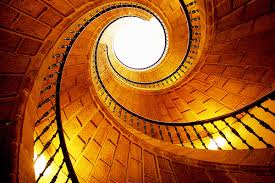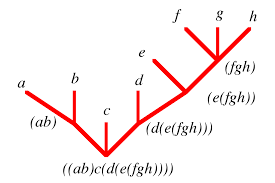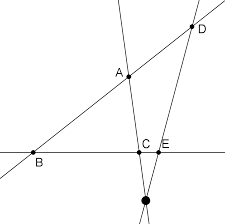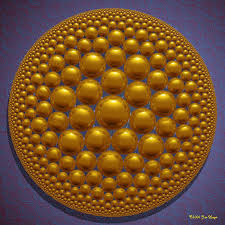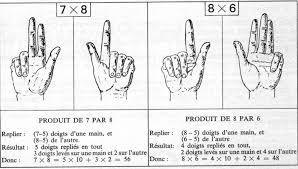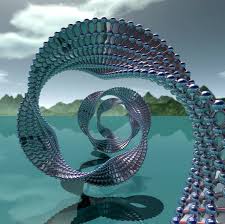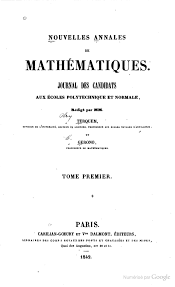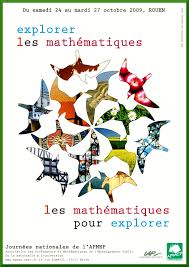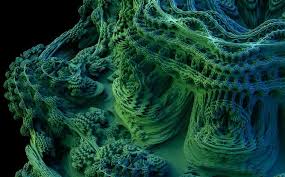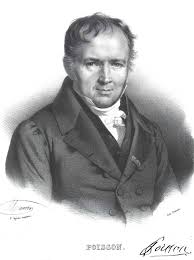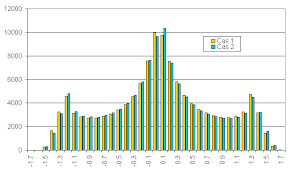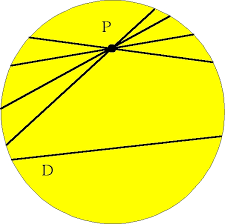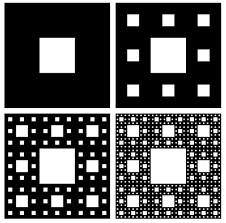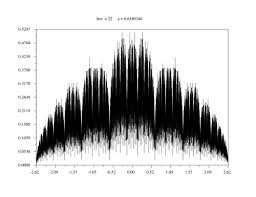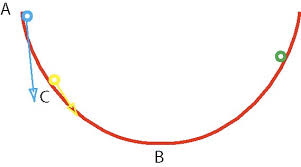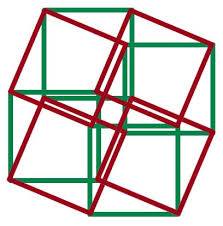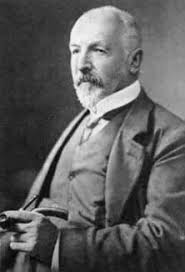14/01/2012
Projet Euclide Project Euclid
08:16 | Lien permanent | Commentaires (0) |  |
|  del.icio.us |
del.icio.us |  |
|  Digg |
Digg | ![]() Facebook
Facebook
Laboratoire de mathématiques de Versailles Annuaire
08:11 Publié dans Annuaires | Lien permanent | Commentaires (0) |  |
|  del.icio.us |
del.icio.us |  |
|  Digg |
Digg | ![]() Facebook
Facebook
13/01/2012
Mathématiques : un dépaysement soudain" à la Fondation Cartier
La fondation Cartier invite la communauté des mathématiciens et sollicite les artistes pour les accompagner dans l'aventure. Ils ont pensé cette exposition ensemble et proposent un "dépaysement soudain", selon la formule du mathématicien Alexandre Grothendieck.
Cette promenade au cœur de la pensée mathématique est un vrai dépaysement, fait de beauté, de poésie, d'enthousiasme et de drôlerie.
"Entre la fondation et les mathématiques, s'est nouée une connivence secrète autour de l'abstraction", explique Michel Cassé, astrophysicien, écrivain et commissaire de l'exposition. "Il s'agit d'une chimère, un mariage entre les mathématiciens et les artistes, qui ne veut pas donner lieu à une cérémonie, mais montrer...
Lire la suite :
http://www.francetv.fr/culturebox/mathematiques-un-depays...
19:37 Publié dans Actualité | Lien permanent | Commentaires (0) |  |
|  del.icio.us |
del.icio.us |  |
|  Digg |
Digg | ![]() Facebook
Facebook
Programme de Hamilton
Programme de Hamilton
Source : http://fr.wikipedia.org/wiki/Programme_de_Hamilton
Le programme de Hamilton est une idée de « plan d'attaque », due à Richard Hamilton, de certains problèmes en topologie des variétés, notamment la célèbre conjecture de Poincaré.
Cet article tente de décrire les raisons d'être de ce programme sans entrer dans les détails.
Sommaire[masquer] |
Idée naïve[modifier]
Dans son article fondateur de 1982, Three-manifolds with positive Ricci curvature, Richard Hamilton introduit le flot de Ricci nommé d'après le mathématicien Gregorio Ricci-Curbastro1. Celui-ci est une équation aux dérivées partielles portant sur le tenseur métrique d'une variété riemannienne : on part d'une métrique g0, que l'on fait évoluer par :

où Ric est la courbure de Ricci de la métrique.
Il est facile de vérifier que les variétés à courbure constante, c'est-à-dire celles munies d'une métrique d'Einstein (en), sont des solitons ou des points fixes généralisés du flot : le flot de Ricci n'agit sur eux que par une dilatation.
On peut alors penser (et les premiers résultats d'Hamilton sur les variétés de dimension 3, ainsi que sur les courbes et surfaces confirment cette impression) que, de même que l'équation de la chaleur a tendance à homogénéiser une distribution de température, le flot de Ricci va « tendre » à homogénéiser la courbure de la variété.
Pour attaquer certains problèmes de topologie, Hamilton pense donc à prendre une variété, la munir d'une métrique riemannienne, laisser agir le flot et espérer récupérer une variété munie d'une métrique à courbure constante. Par exemple, si on part d'une variété simplement connexe, et qu'on récupère ainsi une variété simplement connexe de courbure constante strictement positive, on saura que la variété n'est autre que la sphère.
Nuançons ce propos : même dans la version la plus naïve de son programme, Richard Hamilton n'a jamais pensé obtenir aussi facilement des résultats de topologie. On peut fort bien imaginer que le flot s'arrête en un temps fini, parce que la courbure de la variété explose, soit globalement, soit localement. L'idée serait alors de comprendre et de classer de telles « singularités », et de réussir, à l'aide de découpages, à obtenir plusieurs variétés sur lesquelles on pourrait relancer le flot. L'espoir est qu'in fine, on arrive, après un nombre fini de découpages, à des morceaux à courbure constante. On obtiendrait ainsi, « à la limite », si tout se passe bien, des morceaux de variétés dont on pourrait connaître certaines propriétés topologiques. Notre variété de départ serait donc obtenue en « recollant » ces morceaux sympathiques, ce qui ouvre une voie d'accès aux célèbres conjectures de topologie, comme laconjecture de Thurston.
Existence en temps petit[modifier]
Comme toute ÉDP, l'équation du flot de Ricci ne vérifie pas a priori de principes d'existence et d'unicité qui soit comparable au théorème de Cauchy-Lipschitz pour les ÉDO. Le premier travail d'Hamilton a été de prouver que ce flot existe en temps petit.
Osons une comparaison. On sait que pour l'équation de la chaleur, il existe une unique solution en tout temps, et qu'elle est infiniment dérivable. Or, par certains côtés (la parabolicité), le flot de Ricci ressemble à l'équation de la chaleur. Les équations paraboliques possèdent une théorie générale développée, qui assure l'existence en temps petit de solutions. Cependant, l'équation du flot de Ricci n'est pas à proprement parler parabolique : elle n'est que « faiblement parabolique » : l'existence et l'unicité en temps petit ne sont donc pas garanties par un résultat général.
Un des premiers résultats de Hamilton, et de loin le plus fondamental dans l'étude du flot est donc de prouver ce résultat : il y parvint dans l'article déjà cité, en se basant sur le théorème d'inversion de Nash-Moser. Cependant, de Turck parvint au même résultat dans son article Deforming metrics in the direction of their Ricci tensors de 1983, paru dans le Journal of Differential Geometry, en se ramenant astucieusement à la théorie générale des équations strictement paraboliques.
Principes du maximum[modifier]
Un des outils analytiques principaux de l'étude du flot de Ricci est l'ensemble des principes du maximum. Ceux-ci permettent de contrôler certaines quantités géométriques (principalement mais pas uniquement les courbures) en fonction de leurs valeurs au départ du flot. Plus utilement qu'une longue glose, nous allons énoncer le plus simple d'entre eux : le principe du maximum scalaire.
Soit (M,g) une variété riemannienne et (gt)t une famille de métriques solutions du flot de Ricci sur l'intervalle [0,t0] et ![u : M times [0,t_0] to mathbb R](http://upload.wikimedia.org/wikipedia/fr/math/5/0/a/50a1a3e13749112d916ade5841dd1372.png) une fonction infiniment dérivable vérifiant :
une fonction infiniment dérivable vérifiant :  . Alors, pour tout
. Alors, pour tout ![t in [0,t_0]](http://upload.wikimedia.org/wikipedia/fr/math/f/0/0/f00df28eda61f6a374a9d0c19999a3be.png) ,
,  .
.
Il existe des versions plus compliquées de ce principe : on peut en effet vouloir une hypothèse moins contraignante sur l'équation que vérifie u, ou vouloir l'appliquer à des tenseurs plutôt qu'à des fonctions scalaires, mais l'idée est là : avec une ÉDP sur u, on déduit un contrôle dans le temps à partir d'un contrôle à l'origine.
Ces résultats justifient que l'on cherche à déterminer quelles équations vérifient les grandeurs géométriques associées à une métrique, comme la courbure. C'est ainsi que de l'équation vérifiée par la courbure scalaire R :

on peut déduire que sous le flot de Ricci, le minimum de la courbure scalaire croît.
Une version particulièrement forte de principe du maximum, le théorème de pincement de Hamilton et Ivey, valable uniquement en dimension trois, affirme que sous le flot de Ricci, lescourbures sectionnelles restent contrôlées par la courbure scalaire. Ce théorème est fondamental dans l'étude du flot de Ricci, et son absence en dimension supérieure est une des causes de la rareté des résultats.
Le programme aujourd'hui[modifier]
En trois articles retentissants (The entropy formula for the Ricci flow and its geometric applications, Ricci flow with surgery on three-manifolds et Finite extinction time for the solutions to the Ricci flow on certain three-manifolds), le mathématicien russe Grigori Perelman a exposé de nouvelles idées pour achever le programme de Hamilton. Perelman n'a soumis aucun de ces articles à une revue mathématique et ils sont disponibles sur le site web de diffusion de prépublications arXiv. Dans ces articles, il prétend classer toutes les singularités (les κ-solutions) et faire traverser icelles au flot. Il affirme qu'ils constituent une preuve de la conjecture de Thurston et donc de celle de Poincaré.
N'ayant été soumis à aucune revue, ces articles n'ont d'autre raison d'être lus que leur extraordinaire portée. Leur extrême difficulté et technicité fait que leur lecture est affaire d'années de travail à temps plein pour des mathématiciens renommés. Depuis le congrès international des mathématiciens de 2006, et même si l'ICM ne cite pas explicitement la conjecture de Poincaré dans sa présentation de Perelman, l'idée que le programme de Hamilton est bel et bien achevé est de plus en plus répandue dans la communauté mathématique.
En 2010, l'institut Clay a décerné officiellement à Perelman l'un des prix du millénaire pour sa démonstration de la conjecture de Poincaré, confirmant les considérations ci-dessus.
Notes et références[modifier]
- George Szpiro, La conjecture de Poincaré, JC Lattès, 2007, p. 286.
19:16 | Lien permanent | Commentaires (0) |  |
|  del.icio.us |
del.icio.us |  |
|  Digg |
Digg | ![]() Facebook
Facebook
Institut de mathématiques Clay
FOR IMMEDIATE RELEASE • March 18, 2010
Press contact: James Carlson: jcarlson(à)claymath.org; 617-852-7490
See also the Clay Mathematics Institute website:
• The Poincaré conjecture and Dr. Perelmanʼs work: http://www.claymath.org/poincare
• The Millennium Prizes: http://www.claymath.org/millennium/
• Full text: http://www.claymath.org/poincare/millenniumprize.pdf
First Clay Mathematics Institute Millennium Prize Announced Today
Prize for Resolution of the Poincaré Conjecture a
Awarded to Dr. Grigoriy Perelman
The Clay Mathematics Institute (CMI) announces today that Dr. Grigoriy Perelman of St. Petersburg,
Russia, is the recipient of the Millennium Prize for resolution of the Poincaré conjecture. The citation
for the award reads:
The Clay Mathematics Institute hereby awards the Millennium Prize
for resolution of the Poincaré conjecture to Grigoriy Perelman.
The Poincaré conjecture is one of the seven Millennium Prize Problems established by CMI in
2000. The Prizes were conceived to record some of the most difficult problems with which
mathematicians were grappling at the turn of the second millennium; to elevate in the consciousness
of the general public the fact that in mathematics, the frontier is still open and abounds in important
unsolved problems; to emphasize the importance of working towards a solution of the deepest, most
difficult problems; and to recognize achievement in mathematics of historical magnitude.
The award of the Millennium Prize to Dr. Perelman was made in accord with their governing rules:
recommendation first by a Special Advisory Committee (Simon Donaldson, David Gabai, Mikhail
Gromov, Terence Tao, and Andrew Wiles), then by the CMI Scientific Advisory Board (James
Carlson, Simon Donaldson, Gregory Margulis, Richard Melrose, Yum-Tong Siu, and Andrew Wiles),
with final decision by the Board of Directors (Landon T. Clay, Lavinia D. Clay, and Thomas M. Clay).
James Carlson, President of CMI, said today that "resolution of the Poincaré conjecture by Grigoriy
Perelman brings to a close the century-long quest for the solution. It is a major advance in the
history of mathematics that will long be remembered." Carlson went on to announce that CMI and
the Institut Henri Poincaré (IHP) will hold a conference to celebrate the Poincaré conjecture and its
resolution June 8 and 9 in Paris. The program will be posted on www.claymath.org. In addition, on
June 7, there will be a press briefing and public lecture by Etienne Ghys at the Institut
Océanographique, near the IHP.
Reached at his office at Imperial College, London for his reaction, Fields Medalist Dr. Simon
Donaldson said, "I feel that Poincaré would have been very satisfied to know both about the
profound influence his conjecture has had on the development of topology over the last century and
the surprising way in which the problem was solved, making essential use of partial differential
equations and differential geometry.
Poincaré's conjecture and Perelman's proof
Formulated in 1904 by the French mathematician Henri Poincaré, the conjecture is fundamental to
achieving an understanding of three-dimensional shapes (compact manifolds). The simplest of
- 1 -these shapes is the three-dimensional sphere. It is contained in four-dimensional space, and is
defined as the set of points at a fixed distance from a given point, just as the two-dimensional sphere
(skin of an orange or surface of the earth) is defined as the set of points in three-dimensional space
at a fixed distance from a given point (the center).
Since we cannot directly visualize objects in n-dimensional space, Poincaré asked whether there is a
test for recognizing when a shape is the three-sphere by performing measurements and other
operations inside the shape. The goal was to recognize all three-spheres even though they may be
highly distorted. Poincaré found the right test (simple connectivity, see below). However, no one
before Perelman was able to show that the test guaranteed that the given shape was in fact a threesphere.
In the last century, there were many attempts to prove, and also to disprove, the Poincaré conjecture
using the methods of topology. Around 1982, however, a new line of attack was opened. This was
the Ricci flow method pioneered and developed by Richard Hamilton. It was based on a differential
equation related to the one introduced by Joseph Fourier 160 years earlier to study the conduction of
heat. With the Ricci flow equation, Hamilton obtained a series of spectacular results in geometry.
However, progress in applying it to the conjecture eventually came to a standstill, largely because
formation of singularities, akin to formation of black holes in the evolution of the cosmos, defied
mathematical understanding.
Perelman's breakthrough proof of the Poincaré conjecture was made possible by a number of new
elements. He achieved a complete understanding of singularity formation in Ricci flow, as well as
the way parts of the shape collapse onto lower-dimensional spaces. He introduced a new quantity,
the entropy, which instead of measuring disorder at the atomic level, as in the classical theory of
heat exchange, measures disorder in the global geometry of the space. This new entropy, like the
thermodynamic quantity, increases as time passes. Perelman also introduced a related local
quantity, the L-functional, and he used the theories originated by Cheeger and Aleksandrov to
understand limits of spaces changing under Ricci flow. He showed that the time between formation
of singularities could not become smaller and smaller, with singularities becoming spaced so closely
– infinitesimally close – that the Ricci flow method would no longer apply. Perelman deployed his
new ideas and methods with great technical mastery and described the results he obtained with
elegant brevity. Mathematics has been deeply enriched.
Some other reactions
Fields medalist Stephen Smale, who solved the analogue of the Poincaré conjecture for spheres of
dimension five or more, commented that: "Fifty years ago I was working on Poincaré's conjecture
and thus hold a long-standing appreciation for this beautiful and difficult problem. The final solution
by Grigoriy Perelman is a great event in the history of mathematics."
Donal O'Shea, Professor of Mathematics at Mt. Holyoke College and author of The Poincaré
Conjecture, noted: "Poincaré altered twentieth-century mathematics by teaching us how to
think about the idealized shapes that model our cosmos. It is very satisfying and deeply inspiring
that Perelman's unexpected solution to the Poincaré conjecture, arguably the most basic question
about such shapes, offers to do the same for the coming century.
- 2 -HISTORY AND BACKGROUND
In the latter part of the nineteenth century, the French mathematician Henri Poincaré was studying
the problem of whether the solar system is stable. Do the planets and asteroids in the solar system
continue in regular orbits for all time, or will some of them be ejected into the far reaches of the
galaxy or, alternatively, crash into the sun? In this work he was led to topology, a still new kind of
mathematics related to geometry, and to the study of shapes (compact manifolds) of all dimensions.
The simplest such shape was the circle, or distorted versions of it such as the ellipse or something
much wilder: lay a piece of string on the table, tie one end to the other to make a loop, and then
move it around at random, making sure that the string does not touch itself. The next simplest shape
is the two-sphere, which we find in nature as the idealized skin of an orange, the surface of a
baseball, or the surface of the earth, and which we find in Greek geometry and philosophy as the
"perfect shape." Again, there are distorted versions of the shape, such as the surface of an egg, as
well as still wilder objects. Both the circle and the two-sphere can be described in words or in
equations as the set of points at a fixed distance from a given point (the center). Thus it makes
sense to talk about the three-sphere, the four-sphere, etc. These shapes are hard to visualize, since
they naturally are contained in four-dimensional space, five-dimensional space, and so on, whereas
we live in three-dimensional space. Nonetheless, with mathematical training, shapes in higherdimensional spaces can be studied just as well as shapes in dimensions two and three.
In topology, two shapes are considered the same if the points of one correspond to the points of
another in a continuous way. Thus the circle, the ellipse, and the wild piece of string are considered
the same. This is much like what happens in the geometry of Euclid. Suppose that one shape can
be moved, without changing lengths or angles, onto another shape. Then the two shapes are
considered the same (think of congruent triangles). A round, perfect two-sphere, like the surface of a
ping-pong ball, is topologically the same as the surface of an egg.
In 1904 Poincaré asked whether a three-dimensional shape that satisfies the "simple connectivity
test" is the same, topologically, as the ordinary round three-sphere. The round three-sphere is the
set of points equidistant from a given point in four-dimensional space. His test is something that can
be performed by an imaginary being who lives inside the three-dimensional shape and cannot see it
from "outside." The test is that every loop in the shape can be drawn back to the point of departure
without leaving the shape. This can be done for the two-sphere and the three-sphere. But it cannot
be done for the surface of a doughnut, where a loop may get stuck around the hole in the doughnut.
The question raised became known as the Poincaré conjecture. Over the years, many outstanding
mathematicians tried to solve it—Poincaré himself, Whitehead, Bing, Papakirioukopolos, Stallings,
and others. While their efforts frequently led to the creation of significant new mathematics, each
time a flaw was found in the proof. In 1961 came astonishing news. Stephen Smale, then of the
University of California at Berkeley (now at the City University of Hong Kong) proved that the
analogue of the Poincaré conjecture was true for spheres of five or more dimensions. The higherdimensional version of the conjecture required a more stringent version of Poincaré's test; it asks
whether a so-called homotopy sphere is a true sphere. Smale's theorem was an achievement of
extraordinary proportions. It did not, however, answer Poincaré's original question. The search for
an answer became all the more alluring.
Smale's theorem suggested that the theory of spheres of dimensions three and four was unlike the
theory of spheres in higher dimension. This notion was confirmed a decade later, when Michael
Freedman, then at the University of California, San Diego, now of Microsoft Research Station Q,
announced a proof of the Poincaré conjecture in dimension four. His work used techniques quite
different from those of Smale. Freedman also gave a classification, or kind of species list, of all
simply connected four-dimensional manifolds.
- 3 -Both Smale (in 1966) and Freedman (in 1986) received Fields medals for their work.
There remained the original conjecture of Poincaré in dimension three. It seemed to be the most
difficult of all, as the continuing series of failed efforts, both to prove and to disprove it, showed. In
the meantime, however, there came three developments that would play crucial roles in Perelman's
solution of the conjecture.
Geometrization
The first of these developments was William Thurston's geometrization conjecture. It laid out a
program for understanding all three-dimensional shapes in a coherent way, much as had been done
for two-dimensional shapes in the latter half of the nineteenth century. According to Thurston, threedimensional shapes could be broken down into pieces governed by one of eight geometries,
somewhat as a molecule can be broken into its constituent, much simpler atoms. This is the origin
of the name, "geometrization conjecture."
A remarkable feature of the geometrization conjecture was that it implied the Poincaré conjecture as
a special case. Such a bold assertion was accordingly thought to be far, far out of reach—perhaps a
subject of research for the twenty-second century. Nonetheless, in an imaginative tour de force that
drew on many fields of mathematics, Thurston was able to prove the geometrization conjecture for a
wide class of shapes (Haken manifolds) that have a sufficient degree of complexity. While these
methods did not apply to the three-sphere, Thurston's work shed new light on the central role of
Poincaré's conjecture and placed it in a far broader mathematical context.
Limits of spaces
The second current of ideas did not appear to have a connection with the Poincaré conjecture until
much later. While technical in nature, the work, in which the names of Cheeger and Perelman figure
prominently, has to do with how one can take limits of geometric shapes, just as we learned to take
limits in beginning calculus class. Think of Zeno and his paradox: you walk half the distance from
where you are standing to the wall of your living room. Then you walk half the remaining distance.
And so on. With each step you get closer to the wall. The wall is your "limiting position," but you
never reach it in a finite number of steps. Now imagine a shape changing with time. With each
"step" it changes shape, but can nonetheless be a "nice" shape at each step— smooth, as the
mathematicians say. For the limiting shape the situation is different. It may be nice and smooth, or it
may have special points that are different from all the others, that is, singular points, or
“singularities.” Imagine a Y-shaped piece of tubing that is collapsing: as time increases, the diameter
of the tube gets smaller and smaller. Imagine further that one second after the tube begins its
collapse, the diameter has gone to zero. Now the shape is different: it is a Y shape of infinitely thin
wire. The point where the arms of the Y meet is different from all the others. It is the singular point
of this shape. The kinds of shapes that can occur as limits are called Aleksandrov spaces, named
after the Russian mathematician A. D. Aleksandrov who initiated and developed their theory.
Differential equations
The third development concerns differential equations. These equations involve rates of change in
the unknown quantities of the equation, e.g., the rate of change of the position of an apple as it falls
from a tree towards the earth's center. Differential equations are expressed in the language of
calculus, which Isaac Newton invented in the 1680s in order to explain how material bodies (apples,
the moon, and so on) move under the influence of an external force. Nowadays physicists use
- 4 -differential equations to study a great range of phenomena: the motion of galaxies and the stars
within them, the flow of air and water, the propagation of sound and light, the conduction of heat,
and even the creation, interaction, and annihilation of elementary particles such as electrons,
protons, and quarks.
In our story, conduction of heat and change of temperature play a special role. This kind of physics
was first treated mathematically by Joseph Fourier in his 1822 book, Théorie Analytique de la
Chaleur. The differential equation that governs change of temperature is called the heat equation. It
has the remarkable property that as time increases, irregularities in the distribution of temperature
decrease.
Differential equations apply to geometric and topological problems as well as to physical ones. But
one studies not the rate at which temperature changes, but rather the rate of change in some
geometric quantity as it relates to other quantities such as curvature. A piece of paper lying on the
table has curvature zero. A sphere has positive curvature. The curvature is a large number for a
small sphere, but is a small number for a large sphere such as the surface of the earth. Indeed, the
curvature of the earth is so small that its surface has sometimes mistakenly been thought to be flat.
For an example of negative curvature, think of a point on the bell of a trumpet. In some directions
the metal bends away from your eye; in others it bends towards it.
An early landmark in the application of differential equations to geometric problems was the 1963
paper of J. Eells and J. Sampson. The authors introduced the "harmonic map equation," a kind of
nonlinear version of Fourier's heat equation. It proved to be a powerful tool for the solution of
geometric and topological problems. There are now many important nonlinear heat equations—the
equations for mean curvature flow, scalar curvature flow, and Ricci flow.
Also notable is the Yang-Mills equation, which came into mathematics from the physics of quantum
fields. In 1983 this equation was used to establish very strong restrictions on the topology of fourdimensional shapes on which it was possible to do calculus [D]. These results helped renew hopes
of obtaining other strong geometric results from analytic arguments—that is, from calculus and
differential equations. Optimism for such applications had been tempered to some extent by the
examples of René Thom (on cycles not representable by smooth submanifolds) and Milnor (on
diffeomorphisms of the six-sphere).
Ricci flow
The differential equation that was to play a key role in solving the Poincaré conjecture is the Ricci
flow equation. It was discovered two times, independently. In physics, the equation originated with
the thesis of Friedan [F, 1985], although it was perhaps implicit in the work of Honerkamp [Ho, 1972].
In mathematics it originated with the 1982 paper of Richard Hamilton [Ha1]. The physicists were
working on the renormalization group of quantum field theory, while Hamilton was interested in
geometric applications of the Ricci flow equation itself. Hamilton, now at Columbia University, was
then at Cornell University.
On the left-hand side of the Ricci flow equation is a quantity that expresses how the geometry
changes with time—the derivative of the metric tensor, as the mathematicians like to say. On the
right-hand side is the Ricci tensor, a measure of the extent to which the shape is curved. The Ricci
tensor, based on Riemann's theory of geometry (1854), also appears in Einstein's equations for
general relativity (1915). Those equations govern the interaction of matter, energy, curvature of
space, and the motion of material bodies.
The Ricci flow equation is the analogue, in the geometric context, of Fourier's heat equation. The
idea, grosso modo, for its application to geometry is that, just as Fourier's heat equation disperses
temperature, the Ricci flow equation disperses curvature. Thus, even if a shape was irregular and
- 5 -distorted, Ricci flow would gradually remove these anomalies, resulting in a very regular shape
whose topological nature was evident. Indeed, in 1982 Hamilton showed that for positively curved,
simply connected shapes of dimension three (compact three-manifolds) the Ricci flow transforms the
shape into one that is ever more like the round three-sphere. In the long run, it becomes almost
indistinguishable from this perfect, ideal shape. When the curvature is not strictly positive, however,
solutions of the Ricci flow equation behave in a much more complicated way. This is because the
equation is nonlinear. While parts of the shape may evolve towards a smoother, more regular state,
other parts might develop singularities. This richer behavior posed serious difficulties. But it also
held promise: it was conceivable that the formation of singularities could reveal Thurston's
decomposition of a shape into its constituent geometric atoms.
Richard Hamilton
Hamilton was the driving force in developing the theory of Ricci flow in mathematics, both
conceptually and technically. Among his many notable results is his 1999 paper [Ha2], which
showed that in a Ricci flow, the curvature is pushed towards the positive near a singularity. In that
paper Hamilton also made use of the collapsing theory [C-G] mentioned earlier. Another result
[Ha3], which played a crucial role in Perelman's proof, was the Hamilton Harnack inequality, which
generalized to positive Ricci flows a result of Peter Li and Shing-Tung Yau for positive solutions of
Fourier's heat equation.
Hamilton had established the Ricci flow equation as a tool with the potential to resolve both
conjectures as well as other geometric problems. Nevertheless, serious obstacles barred the way to
a proof of the Poincaré conjecture. Notable among these obstacles was lack of an adequate
understanding of the formation of singularities in Ricci flow, akin to the formation of black holes in the
evolution of the cosmos. Indeed, it was not at all clear how or if formation of singularities could be
understood. Despite the new front opened by Hamilton, and despite continued work by others using
traditional topological tools for either a proof or a disproof, progress on the conjectures came to a
standstill.
Such was the state of affairs in 2000, when John Milnor wrote an article describing the Poincaré
conjecture and the many attempts to solve it. At that writing, it was not clear whether the conjecture
was true or false, and it was not clear which method might decide the issue. Analytic methods
(differential equations) were mentioned in a later version (2004). See [M1] and [M2].
Perelman announces a solution of the Poincaré conjecture
It was thus a huge surprise when Grigoriy Perelman announced, in a series of preprints posted on
ArXiv.org in 2002 and 2003, a solution not only of the Poincaré conjecture, but also of Thurston's
geometrization conjecture [P1, P2, P3].
The core of Perelman's method of proof is the theory of Ricci flow. To its applications in topology he
brought not only great technical virtuosity, but also new ideas. One was to combine collapsing
theory in Riemannian geometry with Ricci flow to give an understanding of the parts of the shape
that were collapsing onto a lower-dimensional space. Another was the introduction of a new
quantity, the entropy, which instead of measuring disorder at the atomic level, as in the classical
theory of heat exchange, measures disorder in the global geometry of the space. Perelmanʼs
entropy, like the thermodynamic entropy, is increasing in time: there is no turning back. Using his
entropy function and a related local version (the L-length functional), Perelman was able to
understand the nature of the singularities that formed under Ricci flow. There were just a few kinds,
and one could write down simple models of their formation. This was a breakthrough of first
importance.
- 6 -Once the simple models of singularities were understood, it was clear how to cut out the parts of the
shape near them as to continue the Ricci flow past the times at which they would otherwise form.
With these results in hand, Perelman showed that the formation times of the singularities could not
run into Zeno's wall: imagine a singularity that occurs after one second, then after half a second
more, then after a quarter of a second more, and so on. If this were to occur, the "wall," which one
would reach two seconds after departure, would correspond to a time at which the mathematics of
Ricci flow would cease to hold. The proof would be unattainable. But with this new mathematics in
hand, attainable it was.
The posting of Perelman's preprints and his subsequent talks at MIT, SUNY–Stony Brook, Princeton,
and the University of Pennsylvania set off a worldwide effort to understand and verify his
groundbreaking work. In the US, Bruce Kleiner and John Lott wrote a set of detailed notes on
Perelman's work. These were posted online as the verification effort proceeded. A final version was
posted to ArXiv.org in May 2006, and the refereed article appeared in Geometry and Topology in
2008. This was the first time that work on a problem of such importance was facilitated via a public
website. John Morgan and Gang Tian wrote a book-long exposition of Perelman's proof, posted on
ArXiv.org in July of 2006, and published by the American Mathematical Society in CMI's monograph
series (August 2007). These expositions, those by other teams, and, importantly, the multi-year
scrutiny of the mathematical community, provided the needed verification. Perelman had solved the
Poincaré conjecture. After a century's wait, it was settled!
Among other articles that appeared following Perelman's work is a paper in the Asian Journal of
Mathematics, posted on ArXiv.org in June of 2006 by the American-Chinese team, Huai-Dong Cao
(Lehigh University) and Xi-Ping Zhu (Zhongshan University). Another is a paper by the European
group of Bessières, Besson, Boileau, Maillot, and Porti, posted on ArXiv.org in June of 2007. It was
accepted for publication by Inventiones Mathematicae in October of 2009. It gives an alternative
approach to the last step in Perelman's proof of the geometrization conjecture.
Perelman's proof of the Poincaré and geometrization conjectures is a major mathematical advance.
His ideas and methods have already found new applications in analysis and geometry; surely the
future will bring many more.
— JC, March 18, 2010## # # # # # # (corrections, 3/19/2010)
# # # # # #
# # # # # # # # # # # # #
# # # # # # # # #
References
[C-G] J. Cheeger and M. Gromov, Collapsing Riemannian manifolds while keeping their curvature bounded. I
and II, J. Differential Geom. Volume 23, Number 3 (1986); Volume 32, Number 1 (1990), 269-298.
[D] S.K. Donaldson. An application of gauge theory to four-dimensional topology. J. Differential Geom., 18,
(1983), 279–315.
[F] D. Friedan, Nonlinear Models in 2 + epsilon Dimensions, Annals of Physics 163, 318-419 (1985)
[Ha1] R. Hamilton, Three-manifolds with positive Ricci curvature, Journal of Differential Geometry, vol.
17:255-306 (1982)
[Ha2] R. Hamilton, Non-singular solutions of the Ricci flow on three-manifolds, Comm. Anal. Geom. 7(4):
695-729 (1999)
[Ha3] R. Hamilton, The Harnack estimate for Ricci flow, Journal of Differential Geometry, vol. 37:225-243
(1993)
- 7 -[Ho] J. Honerkamp, (CERN), Chiral multiloops, Nucl. Phys. B36:130-140 (1972)
[M1] J. Milnor, The Poincaré Conjecture (2000) www.claymath.org/millennium/Poincare_Conjecture/
poincare_2000.pdf
[M2] J. Milnor, The Poincaré Conjecture, in The Millennium Prize Problems, J. Carlson, A. Jaffe, A. Wiles, eds,
AMS (2004) www.claymath.org/millennium/Poincare_Conjecture/poincare.pdf
[P1] G. Perelman, The entropy formula for the Ricci flow and its geometric applications, arXiv.org, November
11, 2002
[P2] G. Perelman, Ricci flow with surgery on three-manifolds, arXiv.org, March 10, 2003
[P3] G. Perelman, Finite extinction time for the solutions to the Ricci flow on certain three-manifolds, arXiv.org,
July 17, 2003
###
- 8 -
Source :
19:14 | Lien permanent | Commentaires (0) |  |
|  del.icio.us |
del.icio.us |  |
|  Digg |
Digg | ![]() Facebook
Facebook
Grigori Perelman
Grigori Perelman
Source :
http://fr.wikipedia.org/wiki/Grigori_Perelman
| Grigori Perelman | |
|---|---|
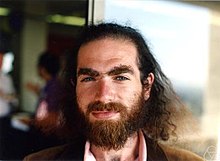 |
|
| Naissance | 13 juin 1966 Léningrad (URSS) |
| Nationalité | |
| Champs | Mathématiques |
| Institution | Institut Steklov Berkeley |
| Diplômé de | Université d’État de Saint-Pétersbourg |
| Renommé pour | Géométrie riemannienne Topologie géométrique |
| Distinctions | Prix du millénaire de l'Institut de mathématiques Clay (2010, refusé) Médaille Fields (2006, refusée) Prix de la Société Mathématique Européenne (1996, refusé) |
| modifier |
|
Grigori Iakovlevitch Perelman (en russe : Григорий Яковлевич Перельман) est un mathématicien russe né le 13 juin 1966 àLéningrad. Il a travaillé sur le flot de Ricci, ce qui l'a conduit à établir en 2002 une démonstration de la conjecture de Poincaré duprogramme de Hamilton, un des problèmes fondamentaux des mathématiques contemporaines. Son approche lui permit également de résoudre en 2003 la conjecture de géométrisation de Thurston, formulée en 1976, et plus générale que la conjecture de Poincaré.
Ancien chercheur à l'Institut de mathématiques Steklov de Saint-Pétersbourg, la personnalité extrêmement discrète de Grigori Perelman a contribué à alimenter les débats sur ses travaux qu'il a présentés à l'occasion d'une série de conférences données auxÉtats-Unis en 2003.
Son résultat sur la conjecture de Poincaré a été officiellement reconnu par la communauté mathématique qui lui a décerné lamédaille Fields le 22 août 2006 lors du congrès international des mathématiciens et par l'Institut de mathématiques Clay qui lui a décerné le prix du millénaire le 18 mars 20101.
Perelman a refusé la médaille Fields2,3,4 et le prix Clay5. Il avait déjà refusé le prix de la Société Mathématique Européenne en 1996.
Sommaire[masquer] |
Biographie[modifier]
Grigori Perelman suit les cours de l'École secondaire no239 de Léningrad, un lycée réputé internationalement pour sa grande sélectivité et son programme extrêmement ambitieux d'apprentissage des mathématiques et de la physique théorique. Il y reçoit en 1982 la médaille d'or avec un score parfait auxOlympiades internationales de mathématiques (42 points sur 42 possibles)6.
De 1982 à 1987, il étudie à l'université de Léningrad d'où il sort diplômé avec mention d'excellence. Il entre comme doctorant à l'Institut de mathématiques Steklov et y soutient sa thèse en novembre 1990. Ses recherches portent sur les surfaces en selle de cheval dans des espaces euclidiens.
Perelman travaille avec Aleksandr Aleksandrov et Iouri Bourago (en), puis collabore avec diverses universités de l'Union soviétique avant de revenir à l'Institut Steklov. Ses travaux sur la théorie des espaces d'Alexandrov à courbure minorée donnent un éclairage nouveau et quasi-définitif sur les conditions de régularité minimale pour certains résultats de géométrie riemannienne : ils lui valent une réputation internationale et une distinction7 de la Société européenne de mathématiques, qu'il refuse.
En 1992, il rejoint l'Institut Courant à New York et l'université de Stony Brook puis l'université de Berkeley pendant deux ans entre 1993 et 1995. Malgré des propositions d'emploi de prestigieuses universités américaines telles que Princeton ou Stanford, il décide de retourner à Saint-Pétersbourg à l'été 1995, puis disparaît quasi complètement du milieu académique, ne publiant plus aucun travail pendant près de 7 ans.
Le 11 novembre 2002, Perelman publie sur la base arXiv un court article de 39 pages. Cette façon de faire est complètement inhabituelle, car il ne passe pas par une revue traditionnelle avec comité de lecture. Il jette ainsi les bases de la démonstration sur la conjecture de Poincaré qu'il complète en publiant deux autres articles par la même voie. En 2003, il sort enfin du silence en donnant plusieurs conférences aux États-Unis sur le sujet.
En décembre 2005, il quitte l'Institut Steklov, où il travaillait depuis plus de 15 ans. Le 22 août 2006, lors de la remise de la médaille Fields à Madrid, il ne se présente pas, comme il l'avait fait savoir deux mois avant.
Depuis, Grigori Perelman évite les médias et vit reclus dans le quartier populaire de Kouptchino à Saint-Petersbourg. Il semble avoir abandonné toute recherche en mathématiques5.
En avril 2011, Perelman accorde cependant un entretien publié dans le quotidien russe Komsomolskaïa Pravda : il y confie avoir cherché à s'« entraîner le cerveau » depuis son enfance avec des problèmes « difficiles à résoudre », par exemple : « Vous vous souvenez de la légende biblique sur Jésus-Christ qui marchait sur l'eau. Je devais calculer la vitesse avec laquelle il marchait pour ne pas tomber dedans »8 ; concernant son refus du prix, il explique : « Je sais comment gouverner l'Univers. Pourquoi devrais-je courir après un million ?! »8.
Distinctions et récompenses[modifier]
Le 22 août 2006, Perelman devait recevoir la médaille Fields, lors du congrès international des mathématiciens. C'est la plus haute distinction dans le domaine des mathématiques, décernée tous les quatre ans à deux, trois ou quatre mathématiciens. Il devait être récompensé pour ses contributions en géométrie et ses idées révolutionnaires sur la structure analytique et géométrique du flot de Ricci9.
Toutefois, Perelman ne s'est pas rendu à la cérémonie et a refusé la médaille. En 1996, il avait déjà refusé le prestigieux prix de la Société européenne de mathématiques. Il est souvent décrit par ses collègues comme une personne timide, peu loquace, concentrée sur son travail, sans être un total ermite.
Perelman devait normalement recevoir également un des prix du millénaire, offerts par l'Institut de mathématiques Clay, s'élevant à un million de dollars américains. Toutefois, Perelman n'a pas publié sa preuve dans une revue de recherche avec comité de lecture, comme stipulé dans les règles du prix, même si ses publications électroniques sur l'arXiv ont été très largement relues et des preuves complètes explicitant sa méthode publiées. C'est pourquoi l'Institut de mathématiques Clay a changé cette condition et, après quelques années, lui a décerné ce prix le 18 mars 2010. Mais Perelman a aussi refusé ce prix. Il était même absent au colloque officiel dédié à la résolution de la conjecture, et tenu à l’Institut Henri-Poincaré, à Paris, les 8 et 9 juin 2010.
Notes et références[modifier]
- (en) Communiqué de presse [archive] [PDF] de l'Institut de mathématiques Clay
- (en) « Maths genius declines top prize » [archive], BBC News, 21 août 2006.
- « Le mathématicien russe Grigory Perelman a refusé la médaille Fields » [archive], Le Monde, 22 août 2006.
- « Perelman refuse la médaille Fields » [archive], La Libre Belgique, 23 août 2006.
- « Génie des maths, il refuse un prix d'un million de dollars » [archive], Le Figaro, 24 mars 2010.
- Résultats Olympiades 1982 [archive]
- Prix Société mathématique européenne 1996 [archive]
- « Le problème de Jésus a mené le mathématicien russe à la solution de Poincaré » [archive], dépêche AFP (via Le Point), 28 avril 2010.
- (en) Communiqué officiel de l'ICM [archive] [PDF]
Annexes[modifier]
Bibliographie[modifier]
- George Szpiro, La Conjecture de Poincaré : comment Grigori Perelman a résolu l'une des plus grandes énigmes mathématiques, JC Lattès, 2007, 408 p. (ISBN 9782709629508)
- J.-J. Dupas, « L'énigmatique Grigori Perelman », Tangente, septembre-octobre 2006, p. 8-10
Articles connexes[modifier]
- Programme de Hamilton
- Conjecture de Poincaré
- Conjecture de géométrisation
- Variété topologique
- Liste des conjectures
Liens externes[modifier]
- « Génie des maths, il refuse un prix d'un million de dollars », article du Figaro.
- « Conjecture de Poincaré : les révélations de Perelman », article de Futura-Sciences.
- « Perelman aurait vu juste : l'hypothèse de Poincaré serait démontrée », article de Futura-Sciences.
- « Le génie des maths retiré du monde » article du JDD.
19:09 Publié dans Grigori Perelman | Lien permanent | Commentaires (0) |  |
|  del.icio.us |
del.icio.us |  |
|  Digg |
Digg | ![]() Facebook
Facebook
Les grands problèmes mathématiques Ils orientent l'avenir des maths DOSSIER POUR LA SCIENCE - N°74 - JANVIER - MARS 2012

Les grands problèmes mathématiques
Ils orientent l'avenir des maths
Les mathématiques ont leurs sept merveilles ! Il s’agit des sept problèmes du millénaire, mis à prix à un million de dollars chacun par l’Institut Clay de mathématiques en 2000. Mais l’intelligence des mathématiciens est aussi mise à l’épreuve par bien d’autres problèmes, tels ceux de Hilbert. Découvrez dans ce numéro comment ces énigmes orientent l’avenir de la discipline ouvrant la voie à de nouvelles connaissances fondamentales.
http://www.pourlascience.fr/ewb_pages/s/sommaire_pls.php?...
15:19 | Lien permanent | Commentaires (0) |  |
|  del.icio.us |
del.icio.us |  |
|  Digg |
Digg | ![]() Facebook
Facebook
08/01/2012
George BOOLE Première édition An Investigation of the Laws of Thought on which are Founded the Mathematical Theories of Logic and Probabilities


An Investigation of the Laws of Thought: on which are Founded the Mathematical Theories of Logic and Probabilities,
BOOLE (George)
- Libraire : Jeffrey Stern Antiquarian/STERN ACADEMIC (York, NYK, United Kingdom)
- Evaluation du vendeur :

- Quantité : 1
Détails bibliographiques
Titre : An Investigation of the Laws of Thought: on ...
Reliure : Hardcover
Edition : 1st Edition
POUR COMMANDER ou POUR PLUS D'INFORMATION
20:12 | Lien permanent | Commentaires (0) |  |
|  del.icio.us |
del.icio.us |  |
|  Digg |
Digg | ![]() Facebook
Facebook
NEWTON, ISAAC Principes Mathématiques de la Philosophie Naturelle Par feue Madame la Marquise du Chastellet Edition 1759

Principes Mathématiques de la Philosophie Naturelle.
NEWTON, ISAAC:
- Libraire : Peter Grosell, Antiquarian Bookseller (Copenhagen K, Denmark)
- Evaluation du vendeur :

- Quantité : 1
Détails bibliographiques
Titre : Principes Mathématiques de la Philosophie ...
Éditeur : 1759
Date d'édition : 1759
Reliure : Soft cover
Edition : 1st Edition
19:20 | Lien permanent | Commentaires (0) |  |
|  del.icio.us |
del.icio.us |  |
|  Digg |
Digg | ![]() Facebook
Facebook
Gaspard MONGE Date d'édition : 1799 Géométrie descriptive. Lecons données aux Écoles Normales, l An 3 de la République.

Géométrie descriptive. Lecons données aux Écoles Normales, l An 3 de la République.
Monge, Gaspard.
- Libraire : Antiquariat MEINDL & SULZMANN OEG (Wien - Vienna, W, Austria)
- Evaluation du vendeur :

- Quantité : 1
11:58 | Lien permanent | Commentaires (0) |  |
|  del.icio.us |
del.icio.us |  |
|  Digg |
Digg | ![]() Facebook
Facebook






